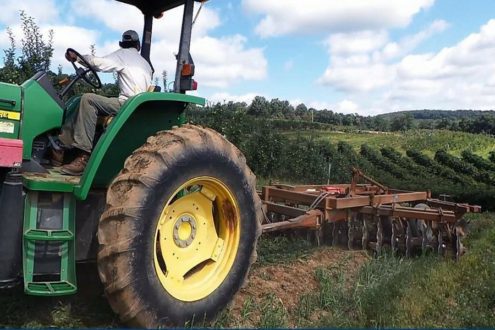May 26, 2017Consider a June planting of sorghum sudangrass following orchard removal
Sorghum sudangrass hybrids, also called sudex, are crosses between forage-type sorghums and sudangrass. You can wait until your spring rush is over to plant sudangrass hybrids since they are heat-loving, yet fast-growing. They penetrate compacted subsoil if mowed at least once and also smother weeds, manage some nematode species, suppress diseases, and replenish soil tilth.
In four “Models for the Future” apple plotsprepared with funds from a beginning farmer grant, a summer planting of sorghum sudangrass followed by a fall planting of rapeseed reduced dagger nematode counts to the zero tolerance level for this virus vector. By planting at a high seeding rate, we also saw a reduction in problem weeds such as yellow nutsedge, green foxtail, and smooth pigweed. The sudangrass survived summer drought and produced high quantities of biomass. This additional organic matter should help reduce the availability of toxic herbicide residues from the previous planting while reducing soil compaction.
We selected Pioneer 877F, a hybrid variety shown by Cornell scientists to have significant activity against nematodes.Your supplier may have another variety that has similar efficacy. The bio-renovation practices we followed were based on research by John Halbrendt, Penn State professor emeritus of nematology.

Sorghum sudangrass suppresses dagger nematodes, problem weeds, and soil-borne diseases, while it improves soil health. Plant in early to mid-June. Photo: T. Baugher, Penn State
Steps to Establishing and Incorporating Sudangrass
Spring following orchard removal
- Rip soil thoroughly to expose additional roots and large rocks for removal.
- Collect samples for soil and nematode tests (soil test to include organic matter as well as pH and nutrient levels).
- Treat the entire site with glyphosate to eliminate perennial weeds.
- Apply lime to adjust soil pH to 6.5 and incorporate by deep plowing. If more than 1,500 pounds of total oxides per acre are required, apply half before plowing and incorporate the remaining half after plowing by disking.
- Broadcast 50 pounds of actual nitrogen per acre along with the required amounts of phosphorus and potassium needed for forage crops, based on soil test results, and incorporate these materials as the killed vegetation is plowed or disked under.
- In early to mid-June, plant the sorghum sudangrass. Drill at 35 to 40 lb per acre, as deep as 2 inches to reach moist soil. If surface moisture is adequate, broadcasting the seed is an option; however, increase the rate to 45 to 50 lb per acre.
Mid-July through Mid-September
- Mow sudangrass when stalks are 3 to 4 feet tall, leaving at least 6 inches of stubble. This encourages the production of side shoots and deeper root growth, while continuing to suppress weeds. Mowing at this stage also prevents the sudangrass from getting too woody.
- Add additional nitrogen to support regrowth. If you plan to plant rapeseed in the fall (i.e., dagger nematodes were present in the soil assay), add 75 to 100 lb per acre of ammonium sulfate. The sulfur may acidify the soil slightly, but it should increase the amount of toxic materials produced in the following rapeseed crop.
- In mid-August, mow sudangrass using a flail mower or other strategy to chop and macerate the grass as much as possible. Incorporate the residue immediately and follow with a cultipacker. It’s best not to mow down more area than can be plowed under within two hours.
Notes: The soil conditions during sudangrass incorporation should be similar to those for soil fumigation, i.e., some soil moisture and soil temperatures above 50° F. Mowing injures the plants and initiates a process that releases nematicidal compounds into the soil. Failure to incorporate and seal chopped plant material into the soil quickly allows much of these available toxicants to escape by volatilization. A steady rain following disking will also prevent escape of volatiles.

Mow sudangrass about a month after planting, when stalks are 3 to 4 feet tall. Use a flail mower in August when it’s time to incorporate the sudangrass. Chopping increases nematicidal potential. Photo: T. Baugher, Penn State

Immediately incorporate the sorghum sudangrass. Photo: T. Baugher, Penn State

Seal with a cultipacker. It’s best not to mow down more area than can be incorporated within two hours. Photo: T. Baugher, Penn State
The “Models for the Future” plots are serving as “living classrooms” where Penn State educators and growers learn from each other. The sorghum sudangrass has been equally successful in our model small fruit and vegetable plots. We extend special appreciation to our grower cooperators—Jake Scholl, Brett Saddington, Michael and Jesse King, David Deardorff, Arturo Diaz, Anton Shannon, Lisa Miskelly, Joe Buzzelli, David and Art King, Alfonso Manzo, and Corey and Vicky McCleaf.
Using grower records from this project, Lynn Kime developed interactive budgets for making decisions on orchard replant practices. For example, the reduction of dagger nematodes to the zero tolerance level resulted in an economic savings of $1000 to $2000 per acre based on the cost of nematicides, and the addition of organic matter represented a potential economic benefit of $1030 per acre based on the costs of compost and application.
Additional cover cropping and pre-plant practices are discussed in a Penn State Extension videoand in several fact sheets.
The USDA Sustainable Agriculture Research and Education website has a useful resource on sorghum sudangrass hybrids.
To learn more about the model plots and “living classroom” demonstrations in your region of the state, contact:
- Eastern Pennsylvania – Megan Chawner or Kathy Salisbury
- Western Pennsylvania –Lee Stivers or Bob Pollock
- Central Pennsylvania – Mike Basedow, Tara Baugher, or Rob Crassweller
- Project Coordinator – Marley Cassidy
This project is supported by the Agriculture and Food Research Initiative of the National Institute of Food and Agriculture, Grant # 2015-70017-22852.















